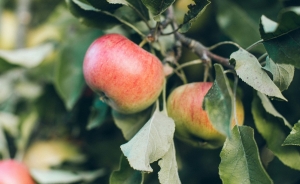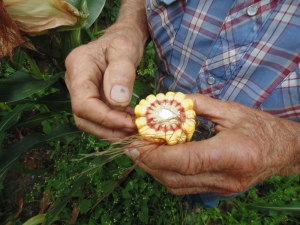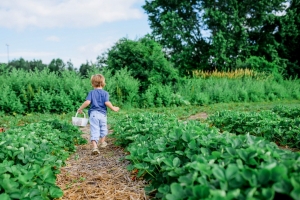CHARLESTON, W.Va. — The West Virginia fall harvest is particularly meaningful for state natives. As the crisp air of late summer settles over the Appalachian hills, the agricultural landscape of West Virginia comes alive with a tapestry of colors and flavors. From the nostalgic scent of apple orchards to the vibrant hues of pumpkins dotting the fields, its harvest season evokes a deep connection to tradition and community.
Let's delve into the most notable late summer and fall harvests in West Virginia, highlighting both the romantic allure of seasonal crops and the economic significance of agriculture, especially in light of the work-from-home revolution.
The Romance of Apples

West Virginia's apple orchards are a hallmark of the West Virginia fall harvest. The harvest season extends from July through October, with varieties ripening at different times to ensure a continuous supply. Early-season apples like Red Delicious and Empire typically appear in mid-September, while late-season varieties such as Granny Smith and Fuji are typically harvested into early November.
The state's diverse topography and climate create ideal conditions for apple cultivation, resulting in apples that are both flavorful and aromatic. The sight of orchards laden with fruit, the sound of leaves rustling in the breeze, and the taste of freshly picked apples all contribute to the romantic imagery associated with autumn in West Virginia. Read about the history of West Virginia's most famous apples.
Pumpkins: A Seasonal Staple
The West Virginia fall harvest wouldn't be complete without pumpkins, and the Mountain State's fields are abundant with them. Typically planted in late spring, pumpkins are harvested in late summer to early fall. Their bright orange hue and distinctive shape make them a favorite for decorations, pies, and festivals.
Local farms often host pumpkin patches, inviting families to pick their own pumpkins and participate in harvest festivals. These events celebrate the community's agricultural heritage and offer an opportunity to savor the simple pleasures of the season.
Corn and Tomatoes

Sweet corn and tomatoes are staples in West Virginia gardens, embodying the state's agricultural traditions. Sweet corn is typically harvested in late summer, while tomatoes reach their peak in late summer to early fall. These crops are often enjoyed fresh, canned, or preserved for use throughout the year.
The cultivation of these vegetables is deeply ingrained in the state's culture. Many families continue to grow their own, passing down techniques and recipes through generations. The shared experience of the West Virginia fall harvest and the preparation of its crops fosters a sense of community and continuity.
The Industrial Harvest

Beyond the picturesque orchards and pumpkin patches lies a robust agricultural industry that significantly contributes to West Virginia's economy. Apples, in particular, are a major commodity. The state's apple industry supports numerous jobs in farming, packing, and distribution. Additionally, the production of apple-based products such as cider, applesauce, and dried apples adds value to the harvest and supports local businesses.
Pumpkin production, although more localized, also contributes to the state's economy. Local farms supply pumpkins to regional markets and festivals, supporting agritourism and small businesses.
The Role of Farmers' Markets
Farmers' markets are central to West Virginia's agricultural community, especially during the harvest season. These markets offer a platform for local farmers to sell their produce directly to consumers, thereby fostering a connection between growers and the community. They also serve as gathering places for residents to share recipes, gardening tips, and stories.
The popularity of farmers' markets has increased in recent years, reflecting a broader interest in locally sourced food and sustainable agricultural practices. These markets not only support local economies but also promote healthier eating habits and environmental stewardship. Find out more through the West Virginia Farmers Market Association.
Economic Impact of Agriculture
Agriculture is a cornerstone of West Virginia's economy, with a significant portion of the state's land dedicated to farming. The late summer and fall harvests contribute substantially to the state's agricultural output, supporting jobs in farming, processing, and distribution.
In addition to traditional crops, the state has experienced growth in niche markets, including organic produce, specialty foods, and agritourism. These sectors provide new opportunities for farmers and contribute to the diversification of the state's agricultural economy.
A Season of Reflection
As the harvest season draws to a close, it offers a time for reflection. The bounty of the land serves as a reminder of the hard work and dedication of West Virginia's farmers. It also underscores the importance of preserving agricultural traditions and supporting local food systems.
The romantic associations with autumn—the golden hues of apple orchards, the earthy scent of pumpkins, and the communal spirit of harvest festivals—are not just nostalgic memories but living traditions that continue to shape West Virginia's identity.
West Virginia fall harvest festivals
West Virginia fall harvest festivals are vibrant celebrations that bring communities together to honor the season’s agricultural bounty and the rich traditions of Appalachian farming. Often held in late summer and fall, they showcase local produce like apples, pumpkins, corn, and squash, alongside crafts, music, and traditional foods.
Events such as the Golden Delicious Festival and the Preston County Buckwheat Festival highlight the cultural importance of the harvest season, drawing both locals and visitors eager to experience the sights, tastes, and sounds of rural West Virginia. These gatherings not only celebrate the land’s abundance but also reinforce community bonds, passing down agricultural knowledge and folklore from one generation to the next.
Beyond their cultural significance, West Virginia fall harvest festivals play a vital economic role by supporting local farmers, artisans, and small businesses. They provide a marketplace for fresh, locally grown produce and handmade goods, fostering agritourism and encouraging sustainable farming practices.
Many festivals include activities like apple picking, hayrides, and cooking demonstrations that educate attendees about the state’s agricultural heritage. As such, harvest festivals are more than just seasonal celebrations—they serve as important platforms that strengthen West Virginia’s agricultural economy and preserve its unique rural identity.
Work-From-Home Gardening
The work-from-home revolution sweeping across West Virginia has fundamentally reshaped how many residents allocate their time, allowing a growing number to reconnect with nature and engage more deeply in gardening. As remote work eliminates lengthy commutes to urban office buildings or industrial sites, individuals find themselves with newfound hours each day to cultivate their own gardens.
According to the W.Va. Department of Commerce, this shift is especially significant in the Mountain State, where rural landscapes and fertile soil make home gardening both accessible and rewarding. According to a 2021 report by the West Virginia Department of Commerce, the rise in telecommuting has contributed to an increase in residential interest in home-based hobbies, such as gardening, as people seek to improve their quality of life and enhance self-sufficiency amid the changing work environment.
Beyond just saving time, remote work allows residents to integrate gardening into their daily routines more seamlessly. Instead of spending two or more hours commuting to cities, many West Virginians now spend those hours planting vegetables, tending to flowers, or harvesting seasonal crops right outside their doors.
This lifestyle change supports not only personal well-being but also local food resilience and sustainability. According to the American Community Gardening Association, gardening has become a therapeutic outlet and a practical response to supply chain disruptions experienced during the COVID-19 pandemic. A survey conducted by the association highlighted that remote workers across rural areas, including West Virginia, reported increased gardening activities since 2020, reinforcing how flexible work arrangements are fostering a renewed connection to the land.
West Virginia fall harvest in perspective
West Virginia is an excellent place to grow crops thanks to its fertile soils, varied elevation, and favorable climate, which together create diverse microclimates ideal for a wide range of produce. The state’s rich river valleys, such as those along the Ohio and Potomac, offer deep, well-drained soils perfect for crops like corn, tomatoes, and apples, while its cooler mountain regions extend growing seasons for certain fruits and vegetables.
Abundant rainfall, averaging 40–60 inches annually depending on location, supports consistent moisture for crops without the need for extensive irrigation. Combined with a strong tradition of family farming and access to local and regional markets, West Virginia’s natural conditions make it both productive and adaptable for everything from backyard gardens to commercial agriculture.
The West Virginia fall harvest is a testament to the state's rich agricultural heritage and its evolving role in the modern economy. From the romantic allure of seasonal crops to the economic significance of industrialized agriculture, the harvest season encapsulates the essence of West Virginia's connection to the land and its community. As we celebrate this season, we honor the past, embrace the present, and look forward to a future where agriculture continues to thrive in the Mountain State.
Sign up to receive a FREE copy of West Virginia Explorer Magazine in your email weekly. Sign me up!




I love you and I love West Virginia!
Such a lovely read about West Virginia’s Fall Harvest! 🍂 The vibrant traditions and local charm truly make it special. saveplus.in